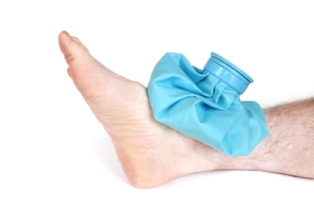Health Blog
An Ankle Sprain Doesn't Have To Be A Prolonged Pain

If you are active in sports that require good balance and agility such as basketball, soccer, volleyball, or trail running you have likely twisted your ankle and experienced an ankle sprain or strain. Hopefully, it was a minor injury and you were able to return to your sport quickly. Although most ankle sprains will respond well to self-treatment, studies indicate some individuals will continue to experience pain and activity limitations for several months or even years following an ankle sprain. A recent study revealed that 1 out of 3 individuals reported chronic pain, swelling, or recurrent sprains 7 years after the initial injury. Furthermore, the re-injury rate following an ankle sprain may be as high as 80%. It appears that the traditional management of ankle sprains may not be the most effective way to treat an ankle sprain.
Common treatment following an ankle sprain typically includes rest, ice, elevation, compression, and sometimes a period of immobilization. While these interventions can be an important part of the rehabilitation program, there are additional factors that should be considered for an optimal recovery. Although a brief period of immobilization or support may be necessary following a severe sprain, early ankle mobility exercises and early weight-bearing have been shown to decrease pain and improve motion more quickly than immobilization for several weeks. The ankle ligaments are stronger when they are appropriately stressed during the healing time. Early motion also helps prevent the formation of excessive scar tissue and improves nutrition to the joint. Additionally, hands-on manual therapy techniques to restore ankle mobility and prevent scar tissue formation can dramatically reduce your healing time. Your physical therapist can perform these techniques and guide you with appropriate exercises that will help the ligaments optimally heal but without causing further damage.
Research has also shown muscles around the ankle and the hip that are important for balance become "inhibited" or "shut down" following an ankle sprain. The muscles have a decreased reaction time that is referred to as decreased neuromuscular control. In simple terms you lose the ability of the muscles to quickly react to a uneven surface or quick movement and then you "roll your ankle" again. A progression of strengthening, muscle reaction training, and balance exercises will help ensure your muscles are working properly to prevent future sprains. These exercises are designed to "retrain" the body's reaction time and prevent you from experiencing another ankle sprain.
So, what should you do if you sprain your ankle? Rest, ice, compression, and elevation are a good place to start and that may be enough. If further intervention is necessary, a thorough examination of your motion, strength, and balance should be performed. The exam will also indicate whether or not x-rays are needed, what exercises you should perform, and if you would benefit from hands on treatment. If you suffer from chronic ankle pain or instability, you still may benefit from the interventions above. Advanced techniques are available that will break down scar tissue even years after an injury and help get you back to the activities you love!
February 11, 2011
Back to Health BlogHEALTH BLOG
- A Personalized Physical Therapy Program Can Assist with Whiplash
- Why Older Adults Should Incorporate an Exercise Program
- After an Achilles Injury, Physical Therapists Can Help with Recovery
- AI Can Answer Questions But It’s Best to See a Physical Therapist
- Physical Therapy Can Help With Symptoms of Wryneck
- Reduce the Risk of Pickleball Fractures By Taking Proper Precautions
- Physical Activity May Slow the Progression of Parkinson's Disease
- Too Much Salt in Your Diet? Learn the Dangers of High Sodium Intake
- Suffer From Lower Back Pain? Might Be Time to Take A Break
- The Road to Recovery: Preventing Re-Injury After ACL Surgery
RECENT ARTICLES

- 11 Possible Reasons Your Back HurtsJune 22, 2020

- What Conditions Can a Chiropractor Treat?May 25, 2020

- A Simple Guide to Better PostureApril 30, 2020

- Is Acupuncture Right for Me When I’m Afraid of Needles?March 30, 2020

- Stretching Done Right — How and When to StretchFebruary 26, 2020

